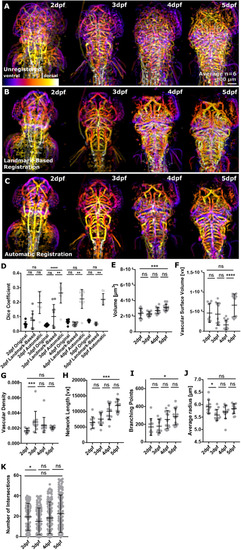- Title
-
Zebrafish Vascular Quantification (ZVQ): a tool for quantification of three-dimensional zebrafish cerebrovascular architecture by automated image analysis
- Authors
- Kugler, E.C., Frost, J., Silva, V., Plant, K., Chhabria, K., Chico, T.J.A., Armitage, P.A.
- Source
- Full text @ Development
|
|
|
|
|
Absent blood flow reduces the cerebral vasculature. (A) MIPs of averaged data of six uninjected controls, control MO and tnnt2a MO following segmentation and registration, showing high inter-embryo similarity in midbrain vessel patterning [PMBC pattern (blue arrowhead), head size (PMBC′ to PMBC″ distance; cyan dotted line), BA (green arrowhead) and PHBC (magenta arrowhead)]. (B) A statistically significant decrease in the Dice coefficient was found when comparing registered control MO to tnnt2a MO (****P<0.0001; uninjected control=15, control MO=18, tnnt2a MO=10; Kruskal–Wallis test; data are mean±s.d.). (C) Vascular volume was statistically significantly decreased in tnnt2a MO (uninjected control, ****P<0.0001; control MO, ****P<0.0001; uninjected control=9, control MO=9, tnnt2a MO=6; one-way ANOVA; data are mean±s.d.). (D) Vascular surface was statistically significantly decreased in tnnt2a MO (uninjected control, P<0.0001; control MO, P=0.0007; Kruskal–Wallis test; data are mean±s.d.). (E) Vascular density was not statistically significantly changed in tnnt2a MO (uninjected control, P=0.6514; control MO, P=0.9082; one-way ANOVA; data are mean±s.d.). (F) Branching points were statistically significantly decreased in tnnt2a MO (uninjected control, P=0.0019; control MO, P=0.0092; Kruskal–Wallis test; data are mean±s.d.). (G) Vascular network length was statistically significantly decreased in tnnt2a MO (uninjected control, P=0.0033; control MO, P=0.0209; Kruskal–Wallis test; data are mean±s.d.). (H) Average vessel radius was statistically significantly decreased in tnnt2a MO (uninjected control, P=0.0050; control MO, P=0.0067; Kruskal–Wallis test; data are mean±s.d.). (I) Vascular complexity was statistically significantly decreased in tnnt2a MO (uninjected control, P=0.0050; control MO, P=0.0067; Kruskal–Wallis test; data are mean±s.d.). |
|
|
|
|
|
|






